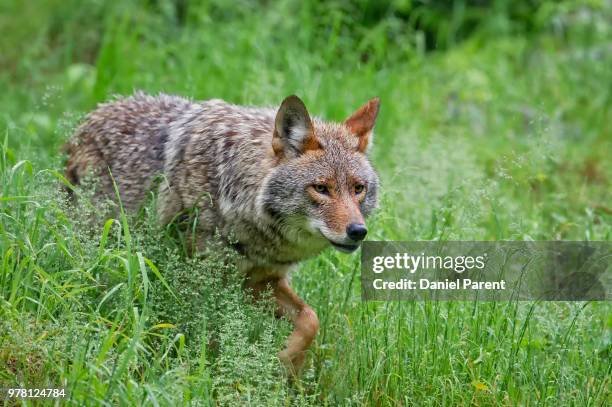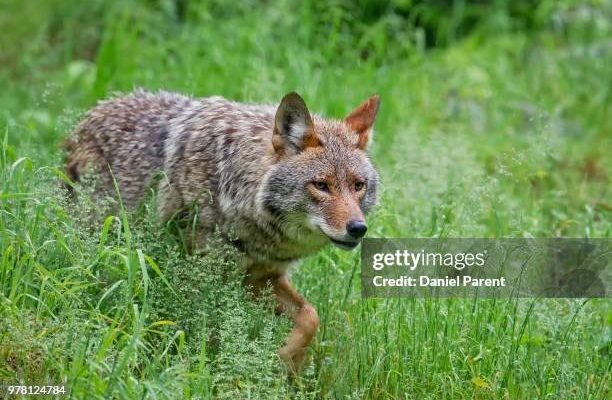
Coyotes are part of the *Canidae* family, alongside wolves and domestic dogs. They’re not just found in remote wilderness; they’ve made a name for themselves in suburban neighborhoods too. This adaptability has helped them flourish in diverse habitats, from the arid Southwest to the cold northern regions of Canada. As we dive deeper, you’ll see just how these remarkable creatures have learned to make the best of their environments and the skills they’ve honed over time.
Understanding Coyote Adaptations
Coyotes are versatile creatures. Their body size and shape are suited for many environments, which is one reason they can thrive in harsh conditions. Generally, they have lean bodies, long legs, and bushy tails, which help them run quickly and navigate different terrains. Think of them as the all-terrain vehicles of the animal kingdom. This physical adaptability allows them to cover great distances in search of food and shelter.
Their fur color can also change with the seasons and the environment. For example, coyotes in snowy areas might have a lighter coat to blend in with their surroundings, while those in deserts tend to have darker shades to help regulate their body temperature. This color adaptation helps them avoid predators while sneaking up on prey. It’s like nature’s version of a high-tech camouflage suit.
Moreover, their keen sense of hearing and smell plays a crucial role in their survival. Coyotes can detect the faintest sounds, like the rustle of a small animal moving through the brush, even from a distance. This sharpness in senses makes them formidable hunters, able to find food even when it’s scarce. Honestly, their ability to adapt physically and behaviorally highlights just how smart these animals truly are.
Dietary Flexibility: The Key to Survival
Coyotes are opportunistic eaters, meaning they’ll munch on whatever is available. This flexibility is vital in harsh environments where food can be hard to come by. Their diet typically includes small mammals, birds, insects, and even fruits or vegetables when animal prey is scarce. They’re nature’s “garbage disposals,” helping to control animal populations while also scavenging on leftover carcasses.
In urban settings, coyotes have also been spotted raiding garbage bins or snacking on pets left unattended. You might be wondering how they find enough food in the wild. The truth is, coyotes have a varied hunting strategy. They often hunt in pairs or small groups, which increases their chances of catching something tasty.
This adaptability to diet doesn’t just help them survive; it also allows them to thrive. During the harsh winter months when smaller animals might be hibernating, coyotes can switch their focus to whatever is available, allowing them to access food sources other predators might overlook. So, whether it’s winter or summer, coyotes have figured out how to stay well-fed.
Social Structure and Communication
Coyotes are also known for their complex social structures and communication methods. They usually live in family groups that consist of a mated pair and their pups. This structure is beneficial for survival, as they work together to raise young and hunt for food. It’s much like having a little team that collaborates for a common goal.
Communication among coyotes is fascinating. They use a variety of vocalizations, from howls to yips and barks, to express themselves and coordinate with each other. For instance, a long howl can serve as a rallying call for the group, letting them know when it’s time to gather or hunt together. This teamwork not only strengthens their social bonds but also boosts their ability to find food and avoid dangers in their environment.
However, you might think that living in packs would make them vulnerable. Yet, their social structure actually enhances their survival odds. They can defend their territory more effectively against intruders, and they’re better equipped to raise their young in a safe environment. It’s a wonderful example of how cooperation can lead to better outcomes in the wild.
Adaptation to Climate: How Coyotes Cope with the Elements
Coyotes are pretty resilient when it comes to weather extremes. In hot deserts, they spend the hottest parts of the day resting in the shade, emerging during cooler mornings and evenings to hunt and socialize. This behavior isn’t just about comfort; it’s a smart survival tactic that helps them conserve energy and avoid dehydration.
When temperatures drop in winter, coyotes adapt in different ways. They grow thicker fur coats, which provides insulation against the cold. Interestingly, they also change their behavior; like humans, coyotes will sometimes huddle together to share body heat during frigid nights. This winter strategy allows them to maintain warmth while resting, ensuring they’re ready to chase down meals when the opportunity arises.
Water scarcity is another challenge for coyotes, especially in arid regions. They’ve learned to survive with very little water, getting most of their hydration from the prey they consume. This ability to adapt to water shortages is a significant advantage, allowing them to thrive even in areas where other animals might struggle to survive.
Living in Urban Environments
In recent years, many coyotes have adapted to urban life, becoming more common in cities and suburbs. You might have noticed them prowling through parks or even backyards. Their ability to navigate human environments showcases their remarkable adaptability.
In cities, coyotes often find food in waste bins, gardens, and even from small pets. They’ve learned to avoid people while hunting, becoming stealthy and elusive. Their behavior can change based on human presence, adjusting their activity patterns to late nights or early mornings when streets are quieter.
This urban adaptation is not without its challenges. Coyotes have to navigate busy roads and human interactions, which can be dangerous. Yet, their intelligence and flexibility help them thrive. Understanding their behaviors can be essential for coexistence, as these cunning canines learn how to adapt to the world humans have created.
The Importance of Coyotes in Their Ecosystem
Coyotes play a crucial role in their ecosystems, acting as natural pest controllers. By keeping populations of smaller mammals in check, they help balance the ecosystem. This balance prevents overgrazing by herbivores, which can lead to vegetation loss and soil erosion.
Moreover, coyotes help to ensure that only the healthiest animals survive in the wild. When they hunt, they often target sick or weak prey. This natural selection process supports healthier animal populations, benefiting the ecosystem as a whole.
Their presence also contributes to the biodiversity of their habitats. By allowing other species to coexist, coyotes create a more dynamic and resilient environment. It’s a lovely reminder that every creature—no matter how small—plays a part in our world.
In conclusion, coyotes are more than just survivors; they’re masters of adaptation. Their ability to thrive in harsh environments speaks to their intelligence, resourcefulness, and resilience. Whether in the wild or urban settings, these fascinating animals continue to surprise and intrigue us with their clever ways of living. Next time you hear a coyote howl in the distance, remember the incredible journey they’re on just to survive.

